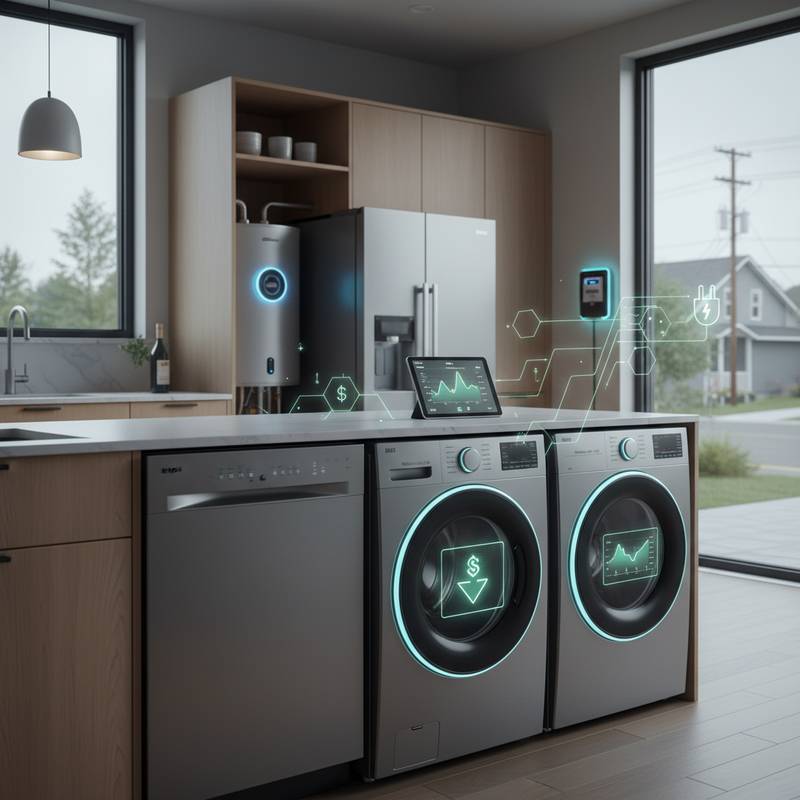Imagine returning home after a full day to find the dishwasher has completed its cycle during a period of low electricity rates. The heat pump has modulated its performance to avoid peak demand times, and the water heater has reheated overnight. No manual intervention is required. This seamless operation stems from smart appliances that integrate directly with utility providers to optimize energy use and lower expenses.
The Importance of Utility-Connected Smart Appliances
Electricity prices vary by time of day, yet traditional homes often ignore these fluctuations, leading to inefficient consumption and elevated bills. Utility-connected smart appliances address this by interfacing with local energy providers or services. These devices modify their functions according to current pricing, demand-response signals, and availability of renewable sources.
This integration benefits both individuals and the broader system. Households achieve cost reductions, while the grid experiences less volatility. Collective shifts in appliance usage across many homes mitigate blackout risks and decrease reliance on costly peak-time power plants. Such adjustments yield substantial network-wide improvements.
Core Technology Enabling These Connections
Smart appliances rely on Wi-Fi, Zigbee, or dedicated cloud platforms to link with home networks and utilities. This setup supports demand-response protocols, which involve brief pauses or modifications in device activity during high-demand intervals.
Contemporary models incorporate these features as standard. For example, a smart washing machine might receive a utility alert to halt mid-cycle temporarily, then continue once demand eases. The interruption remains imperceptible to users, yet it provides meaningful relief to the energy infrastructure.
Many utilities provide incentives for devices bearing 'Connected Appliance' or 'Demand Response Ready' certifications. These qualify for enrollment in savings initiatives, amplifying reductions beyond standard bill decreases.
Establishing a Grid-Responsive Kitchen
Kitchens represent an ideal entry point for integrating grid-aware appliances, given the high energy draw of refrigerators, dishwashers, and ovens. Modern versions interface directly with energy oversight platforms.
-
Select key appliances strategically. Prioritize the refrigerator if upgrading one item. The GE Profile Smart Refrigerator, priced at approximately $1,800, links to Energy Star-approved demand-response schemes.
-
Incorporate adaptable dishwashers. Options like the Whirlpool Smart Dishwasher, at about $950, support utility-triggered delays. It activates automatically during off-peak rate windows, such as nighttime.
-
Opt for advanced models for comprehensive syncing. The LG Signature InstaView Smart Refrigerator, around $3,800, aligns with energy systems and delivers detailed usage analytics via the ThinQ application. These reports reveal savings from peak-time optimizations.
Users retain full control to override signals, preserving priority on comfort and ease.
Extending Responsive Energy Controls to Other Areas
Laundry and water heating systems now participate in demand-response efforts. The Rheem ProTerra Hybrid electric water heater, costing roughly $1,600, relocates heating to low-demand periods. Annual savings from this adjustment often exceed 20 percent.
In laundry rooms, the Samsung Smart Front Load Washer, at about $1,200, integrates via SmartThings with utility programs in supported regions. During price surges, it postpones the spin phase briefly and proceeds after grid pressure subsides.
Utilities increasingly implement hourly time-of-use pricing. Appliances that adapt without user input compound these financial gains effortlessly.
Key Safety and Setup Factors
Prior to linking appliances to utility networks, verify home Wi-Fi security and device certifications for grid interactions. Steer clear of public or vulnerable connections.
Electrical modifications or high-power installations demand a licensed electrician's involvement. Items like water heaters and HVAC systems typically need isolated circuits; faulty setups risk warranty invalidation and hazards.
Renters or residents of shared buildings should consult property managers prior to enrollment. Existing structure-wide programs might overlap, potentially causing redundancies or conflicts in multi-device environments.
Pricing, Setup Duration, and Available Rebates
Appliance costs depend on brand and capabilities:
- Entry-level choices range from $600 to $1,000, featuring Wi-Fi connectivity and simple timers.
- Intermediate selections span $1,000 to $2,000, with built-in utility syncing.
- High-end variants surpass $2,500, offering in-depth monitoring, application controls, and broad system interoperability.
Setup generally concludes within a day, encompassing Wi-Fi pairing and utility platform registration. Provider applications or portals guide the process, often in under 10 minutes.
Incentives abound through 'Connected Home' or 'Demand Response' offerings on utility sites. Certain programs provide yearly stipends per enrolled device.
Ensuring Seamless Integration Across Systems
Unified platforms maximize smart appliance effectiveness. Align choices with existing setups like Google Home, Amazon Alexa, or Samsung SmartThings for fluid operation, automation, and information exchange.
Whirlpool's lineup, for instance, pairs with Alexa to query cycle status or consumption data. LG's ThinQ works natively with Google Home and receives ongoing updates for emerging utility features.
Plan for growth when selecting. Brands with cohesive applications streamline subsequent additions.
Steps to Implement Utility-Synced Appliances
Transitioning to these devices extends beyond acquiring equipment; it fosters a dynamic home aligned with grid needs. Begin modestly with one or two units, leveraging rebates to fuel further adoption.
Engage certified professionals via reliable platforms for installation, ensuring proper smart home and electrical alignment. This approach accelerates deployment and confirms reliable utility communication.
Home energy oversight evolves through these integrations in everyday spaces. Lower bills, reduced ecological impact, and streamlined routines become attainable realities. Position your household as a contributor to the evolving energy landscape, benefiting from appliances that intelligently manage daily demands.
